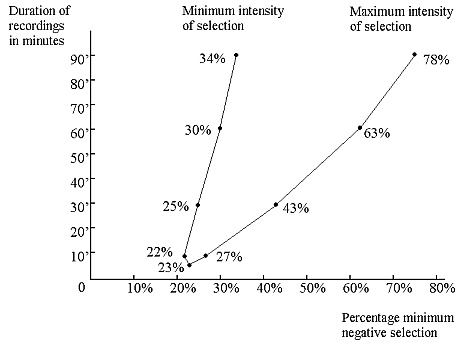The Break-even Point
Take the following supposition:
As long as we succeed in keeping the total time involved in the selection and cataloguing of a certain number of records equal to the time which would have been used for cataloguing without previous selection, there is an advantage for the archive.
Even if we do not win time during the selection and cataloguing processes, we will have less to store and eventually less to preserve. And we are not losing any time by selecting carefully.
However, if we succeed in making the total time involved in selection and cataloguing less than the time originally involved in cataloguing proper without previous selection, then selection becomes even more advantageous. But as soon as selection and cataloguing time add up to a total higher than the cataloguing time without previous selection, we pass the break-even point in the wrong direction. Then the archivist should decide whether problems of space and preservation might counter-balance the loss in time on the selection/cataloguing side.
Now what does the break-even point mean in the case of our hundred records? Taking the figure of 176h 40m involved in the cataloguing of those records (again: 30m average duration, 106m cataloguing per record), if we are going to put those 100 records through the selection process and if we are only going to catalogue the records which were positively selected, we should nevertheless stay within the limit of those 176h 40m in order not to lose time. To find the break-even point in this case becomes a very easy procedure.
We have to go through the selection process anyway for all hundred records. As we have seen this process takes up 43h 20m (again: 30m average duration which means 26m selection per record). Now we only have to subtract those 43h 20m from the 176h 40m mentioned above to find the time which we can safely use for cataloguing proper.
Thus we have 133h 20m left for cataloguing. As long as we stick to 106 minutes per record for the cataloguing of each of these 100 records, we are then able to catalogue about 75 records without going beyond the break-even point. In other words:
There is a break-even point below which it is even more advantageous to select and above which the archive may lose extra time by selection. The break-even point can be found when one subtracts the time involved with the selection process from the total time, which would have been involved with cataloguing all records, in question if there had been no selection. The remaining time is left for cataloguing and should be divided by the time necessary for each separate record in order to find the total number of records, which can safely be considered for cataloguing.
An archivist should in this case instruct his staff to de-select at least one quarter of the pile of one hundred records in order to make the selection a useful tool in the process of saving staff time and money. This assumption is based upon a selection process with minimum intensity. More intensity means a deteriorating ratio, which may even go beyond fifty-fifty.
100 audio-recordings of different duration – fine-mesh selection with different intensity
|
Average duration of recordings |
10m |
30m |
60m |
|||
|---|---|---|---|---|---|---|
| Intensity of selection | min. | max. | min. | max. | min. | max. |
| Total duration of cataloguing if no selection |
160h |
176h 40m |
201h 40m |
|||
| Total duration of selection minus pre-cataloguing phase | 35h | 43h 20m | 43h 20m | 76h 40m | 60h | 126h 40m |
| Total time available for cataloguing after selection | 125h | 133h 20m | 133h 20m | 100h | 141h 40m | 75h |
| Duration of cataloguing per record |
1hr 40m |
1hr 45m |
2h 1m |
|||
| Number( = percentage) of records to be selected for cataloguing | 78 | 73 | 75 | 57 | 70 | 37 |
| Number ( = percentage) of records to be de-selected | 22 | 27 | 25 | 43 | 30 | 63 |
Table 5: calculation of the minimum percentages of audio-recordings of different duration to be de-selected in a fine-mesh selection process of two different intensities, in order to prevent extra loss of time because of selection.
A greater percentage of de-selected records is more advantageous to the archive in terms of timesaving. A lesser percentage means greater loss of time and makes selection disadvantageous in terms of timesaving.

Table 6: minimum negative selection with recordings of different duration


